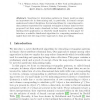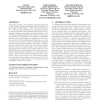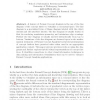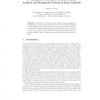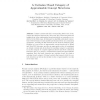112
Voted
GD
1994
Springer
15 years 4 months ago
1994
Springer
Abstract. Concept lattices are used in formal concept analysis to represent data conceptually so that the original data are still recognizable. Their line diagrams should re ect th...
123
Voted
MDAI
2009
Springer
15 years 5 months ago
2009
Springer
Presented is preliminary study of the role of data structures in algorithms for formal concept analysis. Studied is performance of selected algorithms in dependence on chosen data ...
112
Voted
IDA
2009
Springer
15 years 5 months ago
2009
Springer
Searching for interesting patterns in binary matrices plays an important role in data mining and, in particular, in formal concept analysis and related disciplines. Several algorit...
85
Voted
ICFCA
2009
Springer
15 years 5 months ago
2009
Springer
We present an approach to the cell formation problem, known from group technology, which is inspired by formal concept analysis. The cell formation problem consists in allocating p...
125
Voted
SAC
2009
ACM
15 years 5 months ago
2009
ACM
This paper presents a novel software engineering approach for developing a dynamic web interface that meets the quality criterion of “WYDIWYS” - What You Do Is What You See. T...
110
click to vote
ICFCA
2010
Springer
15 years 5 months ago
2010
Springer
A feature of Formal Concept Analysis is the use of the line diagram of the concept lattice to visualize a conceptual space. The line diagram is a specialized form of Hasse diagram ...
108
Voted
RSCTC
2004
Springer
15 years 6 months ago
2004
Springer
The theory of rough sets and formal concept analysis are compared in a common framework based on formal contexts. Different concept lattices can be constructed. Formal concept ana...
116
click to vote
ISCIS
2004
Springer
15 years 6 months ago
2004
Springer
This paper presents a machine-checked proof of the Basic Theorem on Concept Lattices, which appears in the book “Formal Concept Analysis” by Ganter and Wille, in the Isabelle/H...
91
Voted
ICFCA
2004
Springer
15 years 6 months ago
2004
Springer
Abstract. Managing knowledge is a difficult and slippery enterprise. A wide variety of technologies have to be invoked in providing support for knowledge requirements, ranging fro...
114
click to vote
ICCS
2004
Springer
15 years 6 months ago
2004
Springer
Abstract. Infinite contexts and their corresponding lattices are of theoretical and practical interest since they may offer connections with and insights from other mathematical ...

